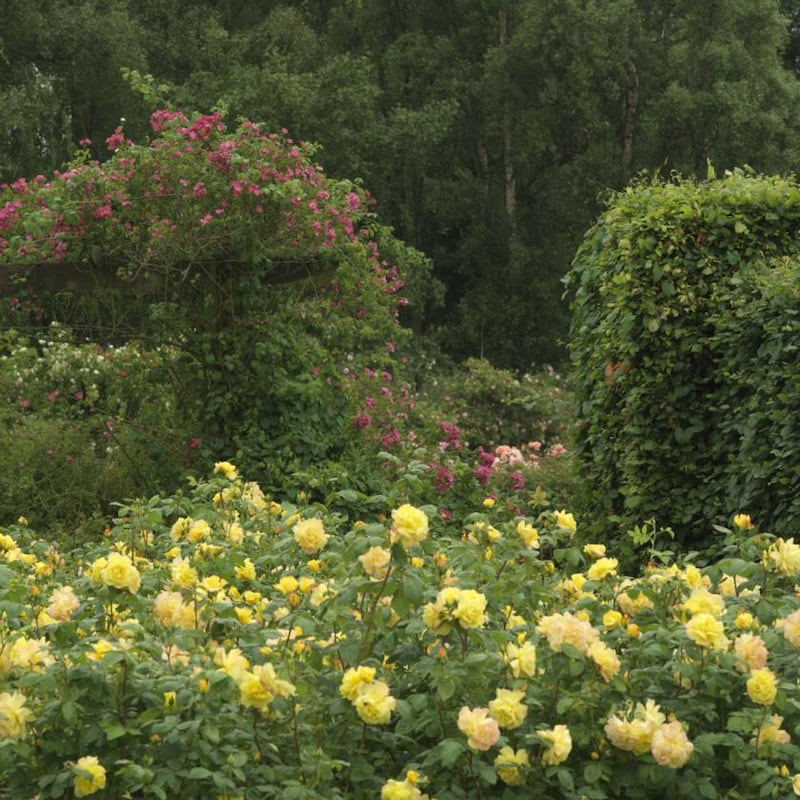Few things feel more counter-intuitive to a gardener than the annual late winter/early spring ritual that is rose pruning. Because if you want your rose plants to grow then why, oh why, you may well wonder to yourself, should you bother cutting them back in the first place. Right?
Wrong. Done well rose pruning not only encourages the production of plenty of strong, healthy new stems (and thus lots of those beautiful flowers) but it also helps to minimise the risk of disease (something, sadly, to which most kinds of roses are infuriatingly prone) as well as to create a well-formed plant of open growth and handsome proportions.
When to prune?
Almost all the textbooks will tell you to hold off until March, but in the National Botanic Gardens in Glasnevin, craft gardener Ita Patton starts pruning its large rose garden in late January and aims to complete the process by mid-February. "Wait much later than that and they'll already be in active spring growth."
The question of how much healthy growth to prune away can so intimidate apprehensive gardeners that they can be tempted to cast away their secateurs and run for the hills
How to prune?
This is (forgive the pun) perhaps the thorniest question. While a certain amount depends on the type of rose (see below), a great way to start is by following the simple rule of the three Ds, which means using a sharp, clean secateurs or loppers to remove any dead, diseased or dying wood.
So any branches that are black/grey/dark brown/obviously discoloured and brittle, or any that show signs of injury/chafing or callousing as these, much like a cut on your finger, could potentially allow disease to infect your rose plants.
For the same reason remove any branches that are crossing/rubbing up against one another as well as any obviously spindly or weak branches.

It’s also important to remove any suckers that may have appeared at the base of grafted rose plants. Slim, pliable, and typically very thorny, these branches grow from the vigorous wild rootstock (the bit of the rose plant below ground) onto which many modern types of roses (the bit above ground) are grafted. Left to their own devices these fast-growing rogue stems will eventually take over, resulting in a rose plant utterly unlike the ‘top’ variety you originally chose for its showy flowers or its attractive repeat-flowering habit.
But don’t try cutting suckers away. Instead you need to gently dig down to expose the spot where they are growing from the rootstock, then pull them cleanly away. But bear in mind that while suckers are a common problem with grafted rose plants, they are a natural part of the growth habit of many species of roses (for example, the popular hedging rose Rosa rugosa) and don’t need to be removed.
Next comes the question of how much healthy growth to prune away, a decision so intimidating to a certain sort of apprehensive gardener that they can be tempted to cast away their secateurs and run for the hills.
If that rings painfully true then please believe me when I tell you that it’s almost impossible to kill a healthy rose bush through poor pruning. Instead the worst that you’re likely to do is to temporarily disfigure it until it grows back. Unfortunate, yes, but not terminal…So be brave.
Young plants need formative pruning, to shape them, while older plants need routine maintenance pruning unless they're really old and neglected
That said, some kinds of roses benefit from a moderately hard late-winter/early-spring routine maintenance pruning (for example, hybrid teas), some prefer a lighter trim (for example, patio roses, climbers and the modern David Austin shrub roses) while others prefer to be left alone at this time of year (for example, ground-cover roses and ramblers).
The age of your rose plant is also relevant to the kind of pruning you should give it. Young plants need what's called formative pruning (to shape them) while older plants need routine maintenance pruning unless they're really old and neglected, in which case they will need to be pruned pretty hard to lick them back into shape. For detailed pruning advice get your hand on a copy of Dr Hessayon's The Rose Expert, an excellent, affordable and practical guide and most professional gardeners' go-to reference book on the subject. Well-known rose breeders David Austin also give step-by-step advice on their website on how best to prune their English shrub roses (davidaustinroses.co.uk).
When she’s training young student gardeners at the National Botanic Gardens in the art of rose pruning, Patton always emphasises the importance of “moving systematically around the plant as you prune, rather than just standing in the same spot”.
“It really helps you to better see the plant as a whole and to imagine the end-result as well as to decide which branches need to be removed. It’s also important not to rush the process. Instead pick a dry, sunny day and take your time.”
Along with a sharp Felco secteurs and a loppers, she also recommends arming yourself with a pair of Showa Floreo gloves (available from all good garden centres) and a thick coat to protect your body from painful scratches. If the plant is a very old and overgrown one, then you may also need a sharp pruning saw to cut away very woody growth.

When you’re pruning back healthy growth the conventional advice is to cut back to just above an outward-facing bud, making a gently sloping cut a little bit above it, but in fact there’s little evidence that this makes much difference.
To minimise the risk of diseased prunings or old rose leaves infecting healthy young growth on your rose plants as it emerges in spring, it’s best to collect and bag them rather than placing them on your compost heap.
For the same reason clear away any weeds or fallen leaves from the base of the plants before finishing off with a soil and health-enriching mulch of well-rotted manure or organic matter, making sure that it doesn't make direct contact with the stems. If you don't have ready access to a nearby source then see geeup.ie and soilrenewireland.ie for great alternatives. Come March your rose plants will also appreciate a sprinkle of slow-release organic granular fertiliser and powdered seaweed around their roots.
This Week in the Garden
There’s still time to lift and divide established clumps of many different kinds of perennials as well as to plant them. Now is also a good time to cut away their dead stems and to gently weed out any invasive perennial weeds such as buttercups, scutch grass or dandelions that have encroached into the clumps, using a small handtool such as a daisy weeder.
While you’re doing that keep a watchful eye out for slugs as well as for slug eggs that may have been overwintering in the heart of established clumps and destroy them to help prevent damage to new growth as it emerges in spring.
Many hardy flowering annuals can be sown at this time of year (under cover, with gentle heat) for transplanting out into their permanent position later this spring to give a colourful display in summer. Examples include sweet pea, ammi, calendula, larkspur (consolida), orlaya, cerinthe, cornflowers and snapdragons. Recommended seed stockists include all good Irish garden centres plus specialist online suppliers including seedaholic.com , chilternseeds.co.uk

Now is a good time to start sowing heat-loving crops such as tomatoes, aubergines, chilli peppers and sweet peppers (under cover and with good bottom heat) for transplanting out into the polytunnel or glasshouse later in the year. Recommended seed suppliers include brownenvelopeseeds.com , irishseedsavers.ie , greenvegetableseeds.com and mrmiddleton.com
But bear in mind that the resulting young seedlings/plants will need plenty of light and moderate heat with protection from cold draughts and chilly nights over the coming months if they are to maintain steady growth.
Electric heat mats, which are available to order from specialist suppliers such as fruithillfarm.com as well as from plenty of online suppliers such as growshop.ie , are an excellent way to provide them with the steady, even bottom-heat they need for good germination and early growth. Suspending a a couple of layers of horticultural fleece over seedlings/young plants will also protect and insulate them.
Dates for Your Diary
Today, 2.30pm, Burtown Gardens, Athy, Co Kildare, galanthophile and professional gardener Assumpta Broomfield will give a guided tour of Burtown's extensive snowdrop collection along with a practical demonstration of how to identify the different species/varieties, see burtownhouse.ie
Wednesday, February 20th, 8pm, parish centre, Church Road, Malahide, "Gardens far and near", a talk by Peter Harvey on behalf of Malahide Horticultural Show, for further details contact John Warren at 087-2561761;
Saturday, February 23rd, the Crown Plaza Conference Centre, Northwood, Santry, Dublin 9, the Garden and Landscape Designers Association (GLDA) 2019 seminar, "Gardening on the Edge; Rewilding Green Spaces", with guest speakers Dusty Gedge of the UK; Irish environmental consultant and wetland specialist Féidhlim Harty; American landscape architect Kevin Sloan; and Monique and Thierry Dronet of Jardin de Berchigranges in northeast France. Tickets from €55 (students), €85 (full members, Friends of the GLDA), €100 (early bird non-members), €110 (non-members). See glda.ie.

















